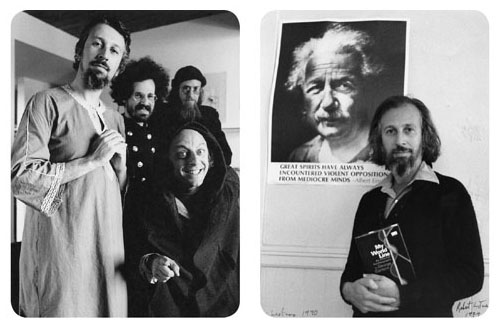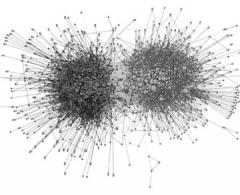
This Article From Issue
July-August 2011
Volume 99, Number 4
Page 332
DOI: 10.1511/2011.91.332
HOW THE HIPPIES SAVED PHYSICS: Science, Counterculture, and the Quantum Revival. David Kaiser. xxviii + 372 pp. W. W. Norton and Company, 2011. $26.95.
In the United States, the job market for people with doctorates in physics collapsed around 1970, as the huge post-Sputnik expansion of American university hiring and military spending came to an abrupt halt. By the mid-1980s, things hadn’t improved much, and it seemed likely that my recent Ph.D. in theoretical physics would be of little use in finding conventional permanent academic employment. One possible career path that came to mind was to try to follow the example of a sizable group of physicists who lived and worked in the San Francisco Bay Area during the 1970s. They appeared to have managed to pursue scientific research by dropping out of academia and adopting a countercultural lifestyle that included soaking in hot tubs at Big Sur, engaging in Tantric sex, hanging out at North Beach cafes and taking psychedelic drugs. Some of them had gotten rich writing books that mixed physics with various kinds of mysticism. I wasn’t very interested in the mysticism part, but I figured I could handle the rest.

From How the Hippies Saved Physics.
For better or worse, I did end up moving to the Bay Area for a year, but as a respectable post-doc in mathematics I saw little or no evidence of the continued existence of these countercultural physicists, and I wondered what had happened to them. David Kaiser’s entertaining new book, How the Hippies Saved Physics, does a wonderful job of recounting the twists and turns of the story of how the members of this group came together, interacted with one another and with the more conventional physics community, and then dispersed to various fates.
Kaiser takes as the center of his account the activities of Jack Sarfatti and other physicists who met from 1975 to 1979 at Lawrence Berkeley Laboratory, sometimes calling themselves the “Fundamental Fysiks Group.” The group, whose core members included John Clauser, Elizabeth Rauscher, Saul-Paul Sirag, Nick Herbert, George Weissmann and Fred Alan Wolf, was open to anyone interested in the interpretation of quantum theory. One subject that occupied its members was what is now known as Bell’s theorem, which shows that quantum systems are “entangled” in a rather counterintuitive way. Although it was a fringe topic at the time, in recent years Bell’s theorem has played a part in the active field of quantum information theory, which raises serious hopes that important new technology such as quantum computers may soon be within reach.
Many members of the Fundamental Fysiks Group had unconventional motivations for their research: Some were hoping to explain parapsychological phenomena, and others were trying find a scheme for faster-than-light communication. Sarfatti has continued this sort of search, supported by various patrons over the years, but more recently his attention has turned to unidentified flying objects (UFOs) and faster-than-light interstellar travel. Other members or associates of the group were responsible for wildly successful popular books, including Fritjof Capra (The Tao of Physics, 1975), Gary Zukav (The Dancing Wu-Li Masters, 1979) and Nick Herbert (Quantum Reality, 1985). Off and on, these books have even found their way into the syllabi of university physics classes.
Kaiser is a professional historian of science, and his account is exhaustively and carefully researched. He has uncovered a wealth of revealing detail about the various physicists involved, making for a very lively tale. One focus is on the significant interaction between the countercultural physicists and the more conventional physics community, and this is taken as evidence for an argument which, like many of those favored by the counterculturalists, is provocative but unconvincing. Kaiser maintains that World War II had led the conventional physics community to abandon philosophical engagement with quantum physics, a mistake only rectified starting in the late 1970s, in part through the impetus of the activities of the Fundamental Fysiks Group. Therefore, he argues, the hippies were responsible for saving the field that had quantum information theory as its future.
There are several problems with this argument. Kaiser makes much of the disappearance of philosophical discussion of quantum theory from physics textbooks and curricula after the war, but there were very good reasons for this. The birth of quantum mechanics in 1925 was followed by dramatic and important debates over the meaning of the formalism (the relationship between the mathematical equations and experiments), but by the war years it was clear that the formalism of quantum theory was sound and highly successful; an ad hoc but workable prescription for its relation to conventional experiment and observation was in place. The issue of how to understand the emergence of the classical world as an approximation was not resolved (and remains unresolved to this day), but it had become clear that for practical purposes the problem could be ignored. Only much later, as technological progress enabled the preparation of larger-scale coherent quantum systems, could experimental investigation of fundamental quantum measurement problems proceed, driving new theoretical work.
Quantum mechanics has generated a huge amount of pseudoscientific nonsense about its supposed relation to the question of consciousness and to parapsychology. Unfortunately, members of the Fundamental Fysiks Group were and are among those responsible for this nonsense, which has seriously damaged their credibility as scientists. In 2004 one of them, Wolf, played the role of Dr. Quantum in What the Bleep Do We Know!?, an atrocious but highly popular film, which argues that proper understanding of quantum physics allows one to make anything happen that one desires. Kaiser does make a good case that the process of debunking Nick Herbert’s proposals for using quantum mechanics for superluminal communication was one historical factor in the development of what is now known as the “no-cloning theorem,” on which quantum encryption technology is based. This, however, is a very long way from making Herbert responsible for saving physics.
To place the story Kaiser tells in context requires noting that, although the job situation in the 1970s was awful, it was during this era that the fantastically successful Standard Model of particle physics fell into place; the Standard Model is a quantum field theory based on fundamental symmetry arguments. But Berkeley was the center of a failed research program (“S-matrix philosophy”) that claimed such a thing couldn’t work. In The Tao of Physics, Capra argued extensively for the triumph of an allied S-matrix/Eastern mysticism point of view (as opposed to a symmetry/Western one), right at the moment that S-matrix philosophy lost the battle. Particle physicists during the 1970s were very busy working out the lessons of a new enlightenment and were not paying much attention to grandiose claims about quantum mechanics coming from a center of reaction.
One of the intriguing issues that the story of the Fundamental Fysiks Group raises, which Kaiser discusses, is what philosophers of science refer to as the demarcation problem. How do you decide what is science and what isn’t? You can’t just decide based on whether someone has a respectable academic position (Einstein didn’t in 1905). A continuum connects the solidest experimentally verified science with the rankest pseudoscience. Some of the work of the countercultural physicists clearly fell into the “legitimate science” portion of the continuum, and some of it just as clearly did not. The demarcation problem has recently reared its head again as debate rages about the scientific status of speculative ideas involving extra dimensions and a supposed Multiverse. This time one center of controversial research is across the Bay from Berkeley at Stanford University, and highly ranked academic figures are involved.
Kaiser’s fascinating book does make one other difference between the countercultural and conventional physicists very obvious: Whether they were doing science or pseudoscience, and whether they saved physics or not, the hippies were having a lot more fun.
Peter Woit is departmental computer administrator and Senior Lecturer in Discipline in the Department of Mathematics at Columbia University. He is the author of Not Even Wrong: The Failure of String Theory and the Search for Unity in Physical Law (Basic Books, 2006). His blog, Not Even Wrong, can be found at http://www.math.columbia.edu/~woit/wordpress/.

American Scientist Comments and Discussion
To discuss our articles or comment on them, please share them and tag American Scientist on social media platforms. Here are links to our profiles on Twitter, Facebook, and LinkedIn.
If we re-share your post, we will moderate comments/discussion following our comments policy.